Multiscale Modelling of Nanoparticle Distribution in a Realistic Tumour Geometry Following Local Injection
Abstract
Simple Summary
Abstract
1. Introduction
2. Materials and Methods
2.1. Mathematical Models
2.1.1. Micro-Model
2.1.2. Macro-Model
2.2. Model Geometries
2.3. Boundary Conditions
2.4. Numerical Details
2.5. Particle Diffusivity and Particle Diameter
3. Results and Discussion
3.1. Particle Trajectory Tracking Model
Varying Particle Surface Charge
3.2. Nanoparticle Transport Model
3.2.1. Varying Particle Surface Charge
3.2.2. Varying Injection Location
4. Conclusions and Future Perspectives
4.1. Conclusions
4.2. Limitations
Author Contributions
Funding
Institutional Review Board Statement
Informed Consent Statement
Data Availability Statement
Conflicts of Interest
References
- Kwatra, D.; Venugopal, A.; Anant, S. Nanoparticles in Radiation Therapy: A Summary of Various Approaches to Enhance Radiosensitization in Cancer. Transl. Cancer Res. 2013, 2, 330–342. [Google Scholar] [CrossRef]
- Caddy, G.; Stebbing, J.; Wakefield, G.; Xu, X.Y. Modelling of Nanoparticle Distribution in a Spherical Tumour during and Following Local Injection. Pharmaceutics 2022, 14, 1615. [Google Scholar] [CrossRef] [PubMed]
- Rockwell, S.; Dobrucki, I.T.; Kim, E.Y.; Marrison, S.T.; Vu, V.T. Hypoxia and Radiation Therapy: Past History, Ongoing Research, and Future Promise. Curr. Mol. Med. 2010, 9, 442–458. [Google Scholar] [CrossRef] [PubMed]
- Wakefield, G.; Gardener, M.; Stock, M.; Adair, M. Nanoparticle Augmented Radiotherapy Using Titanium Oxide Nanoparticles. J. Nanomater. Mol. Nanotechnol. 2018, 7, 1–8. [Google Scholar] [CrossRef]
- Hainfeld, J.F.; Ridwan, S.M.; Stanishevskiy, Y.; Panchal, R.; Slatkin, D.N.; Smilowitz, H.M. Iodine Nanoparticles Enhance Radiotherapy of Intracerebral Human Glioma in Mice and Increase Efficacy of Chemotherapy. Sci. Rep. 2019, 9, 4505. [Google Scholar] [CrossRef]
- Arifin, D.Y.; Lee, K.Y.T.; Wang, C.H. Chemotherapeutic Drug Transport to Brain Tumor. J. Control. Release 2009, 137, 203–210. [Google Scholar] [CrossRef]
- Mahesh, N.; Singh, N.; Talukdar, P. A Mathematical Model for Understanding Nanoparticle Biodistribution after Intratumoral Injection in Cancer Tumors. J. Drug Deliv. Sci. Technol. 2022, 68, 103048. [Google Scholar] [CrossRef]
- Suleman, M.; Riaz, S. In Silico Study of Hyperthermia Treatment of Liver Cancer Using Core-Shell CoFe2O4@MnFe2O4 Magnetic Nanoparticles. J. Magn. Magn. Mater. 2020, 498, 166143. [Google Scholar] [CrossRef]
- Zhan, W.; Gedroyc, W.; Xu, X.Y. Mathematical Modelling of Drug Transport and Uptake in a Realistic Model of Solid Tumour. Protein Pept. Lett. 2017, 44, 36–41. [Google Scholar] [CrossRef]
- Shojaee, P.; Niroomand-Oscuii, H.; Sefidgar, M.; Alinezhad, L. Effect of Nanoparticle Size, Magnetic Intensity, and Tumor Distance on the Distribution of the Magnetic Nanoparticles in a Heterogeneous Tumor Microenvironment. J. Magn. Magn. Mater. 2020, 498, 166089. [Google Scholar] [CrossRef]
- Stylianopoulos, T.; Soteriou, K.; Fukumura, D.; Jain, R.K. Cationic Nanoparticles Have Superior Transvascular Flux into Solid Tumors: Insights from a Mathematical Model. Ann. Biomed. Eng. 2013, 41, 68–77. [Google Scholar] [CrossRef] [PubMed]
- Dahaghin, A.; Emadiyanrazavi, S.; Haghpanahi, M.; Salimibani, M.; Bahreinizad, H.; Eivazzadeh-Keihan, R.; Maleki, A. A Comparative Study on the Effects of Increase in Injection Sites on the Magnetic Nanoparticles Hyperthermia. J. Drug Deliv. Sci. Technol. 2021, 63, 102542. [Google Scholar] [CrossRef]
- Zhan, W.; Gedroyc, W.; Xu, X.Y. Effect of Heterogeneous Microvasculature Distribution on Drug Delivery to Solid Tumour. J. Phys. D Appl. Phys. 2014, 47, 475401. [Google Scholar] [CrossRef]
- Frieboes, H.B.; Wu, M.; Lowengrub, J.; Decuzzi, P.; Cristini, V. A Computational Model for Predicting Nanoparticle Accumulation in Tumor Vasculature. PLoS ONE 2013, 8, e56876. [Google Scholar] [CrossRef] [PubMed]
- Bhandari, A.; Bansal, A.; Singh, A.; Sinha, N. Numerical Study of Transport of Anticancer Drugs in Heterogeneous Vasculature of Human Brain Tumors Using Dynamic Contrast Enhanced-Magnetic Resonance Imaging. J. Biomech. Eng. 2018, 140, 051010. [Google Scholar] [CrossRef]
- Pizzichelli, G.; di Michele, F.; Sinibaldi, E. An Analytical Model for Nanoparticles Concentration Resulting from Infusion into Poroelastic Brain Tissue. Math. Biosci. 2016, 272, 6–14. [Google Scholar] [CrossRef] [PubMed]
- Ma, R.; Su, D.; Zhu, L. Multiscale Simulation of Nanoparticle Transport in Deformable Tissue during an Infusion Process in Hyperthermia Treatments of Cancers. In Nanoparticle Heat Transfer and Fluid Flow; CRC Press: Boca Raton, FL, USA, 2016; pp. 69–96. [Google Scholar] [CrossRef]
- Su, D.; Ma, R.; Zhu, L. Numerical Study of Nanofluid Infusion in Deformable Tissues for Hyperthermia Cancer Treatments. Med. Biol. Eng. Comput. 2011, 49, 1233–1240. [Google Scholar] [CrossRef]
- Soni, S.; Tyagi, H. Investigation of Nanoparticle Injection to a Tissue through Porous Media Theory. In Proceedings of the ICTEA: International Conference on Thermal Engineering, Gujarat, India, 23–26 February 2019; pp. 2–4. [Google Scholar]
- Chou, C.Y.; Chang, W.I.; Horng, T.L.; Lin, W.L. Numerical Modeling of Nanodrug Distribution in Tumors with Heterogeneous Vasculature. PLoS ONE 2017, 12, e189802. [Google Scholar] [CrossRef]
- Astefanoaei, I.; Stancu, A. A Computational Study of the Bioheat Transfer in Magnetic Hyperthermia Cancer Therapy. J. Appl. Phys. 2019, 125, 194701. [Google Scholar] [CrossRef]
- Su, D. Multi-Scale Numerical Study of Nanoparticle Transport in Deformable Tissues during an Infusion Process; University of Maryland: College Park, MD, USA, 2011. [Google Scholar]
- Su, D.; Ma, R.; Salloum, M.; Zhu, L. Multi-Scale Study of Nanoparticle Transport and Deposition in Tissues during an Injection Process. Med Biol. Eng. Comput. 2010, 48, 853–863. [Google Scholar] [CrossRef]
- Nield, D.A.; Bejan, A. Convection in Porous Media; Springer New York: New York, NY, USA, 2013; ISBN 978-1-4614-5540-0. [Google Scholar]
- Tien, C.; Ramarao, B.V. Model Representation of Granular Media. In Granular Filtration of Aerosols and Hydrosols; Elsevier: Amsterdam, The Netherlands, 2007; pp. 59–116. [Google Scholar] [CrossRef]
- Maniero, R.; Canu, P. A Model of Fine Particles Deposition on Smooth Surfaces: I-Theoretical Basis and Model Development. Chem. Eng. Sci. 2006, 61, 7626–7635. [Google Scholar] [CrossRef]
- Messina, F.; Icardi, M.; Marchisio, D.; Sethi, R. Microscale Simulation of Nanoparticles Transport in Porous Media for Groundwater Remediation. In Proceedings of the 2012 COMSOL Conference, Milan, Italy, 10 October 2012. [Google Scholar]
- Ambrosi, D.; Ciarletta, P.; Danesi, E.; de Falco, C.; Taffetani, M.; Zunino, P. A Multiscale Modeling Approach to Transport of Nano-Constructs in Biological Tissues; Springer: Berlin/Heidelberg, Germany, 2017; pp. 109–138. ISBN 9783319733708. [Google Scholar]
- Cox, R.G.; Hsu, S.K. The Lateral Migration of Solid Particles in a Laminar Flow near a Plane. Int. J. Multiph. Flow 1977, 3, 201–222. [Google Scholar] [CrossRef]
- Unni, H.N.; Yang, C. Brownian Dynamics Simulation and Experimental Study of Colloidal Particle Deposition in a Microchannel Flow. J. Colloid Interface Sci. 2005, 291, 28–36. [Google Scholar] [CrossRef] [PubMed]
- Russel, W.B.; Saville, D.A.; Schowalter, W.R. Colloidal Dispersions; Cambridge University Press: Cambridge, UK, 1989; ISBN 9780521426008. [Google Scholar]
- Elimelech, M.; Gregory, J.; Jia, X.; Williams, R.A. Particle Deposition & Aggregation; Elsevier: Amsterdam, The Netherlands, 1995; ISBN 9780750670241. [Google Scholar]
- Huilian, M.; Johnson, W.P. Colloid Retention in Porous Media of Various Porosities: Predictions by the Hemispheres-in-Cell Model. Langmuir 2010, 26, 1680–1687. [Google Scholar] [CrossRef]
- Available online: https://www.hamiltoncompany.com/laboratory-products/needles-knowledge/needle-gauge-chart (accessed on 25 April 2021).
- COMSOL. Particle Tracing Module User’s Guide; COMSOL: Bengaluru, India, 1998. [Google Scholar]
- COMSOL. The CFD Module User’s Guide; COMSOL: Bengaluru, India, 2020. [Google Scholar]
- Yuan, T.; Gao, L.; Zhan, W.; Dini, D. Effect of Particle Size and Surface Charge on Nanoparticles Diffusion in the Brain White Matter. Pharm. Res. 2022, 39, 767–781. [Google Scholar] [CrossRef]
- ISO 22412:2017; Particle Size Analysis—Dynamic Light Scattering (DLS). British Standards Institution: London, UK, 2017.
- Goodman, T.T.; Chen, J.; Matveev, K.; Pun, S.H. Spatio-Temporal Modeling of Nanoparticle Delivery to Multicellular Tumor Spheroids. Biotechnol. Bioeng. 2008, 101, 388–399. [Google Scholar] [CrossRef]
- Elimelech, M. Predicting collision efficiencies of colloidal particles in porous media. Water Res. 1992, 26, 1–8. [Google Scholar] [CrossRef]
- Nelson, K.E.; Ginn, T.R. New Collector Efficiency Equation for Colloid Filtration in Both Natural and Engineered Flow Conditions. Water Resour. Res 2011, 47, 1–17. [Google Scholar] [CrossRef]
- Tufenkji, N.; Elimelech, M. Correlation Equation for Predicting Single-Collector Efficiency in Physicochemical Filtration in Saturated Porous Media. Environ. Sci. Technol. 2004, 38, 529–536. [Google Scholar] [CrossRef]
- Bai, R.; Tien, C. A New Correlation for the Initial Filter Coefficient under Unfavorable Surface Interactions. J. Colloid Interface Sci. 1996, 179, 631–634. [Google Scholar] [CrossRef]
- Suleman, M.; Riaz, S. 3D in Silico Study of Magnetic Fluid Hyperthermia of Breast Tumor Using Fe3O4 Magnetic Nanoparticles. J. Therm. Biol. 2020, 91, 102635. [Google Scholar] [CrossRef] [PubMed]
- Tang, Y.; Flesch, R.C.C.; Jin, T. Numerical Investigation of Temperature Field in Magnetic Hyperthermia Considering Mass Transfer and Diffusion in Interstitial Tissue. J. Phys. D Appl. Phys. 2018, 51, 035401. [Google Scholar] [CrossRef]
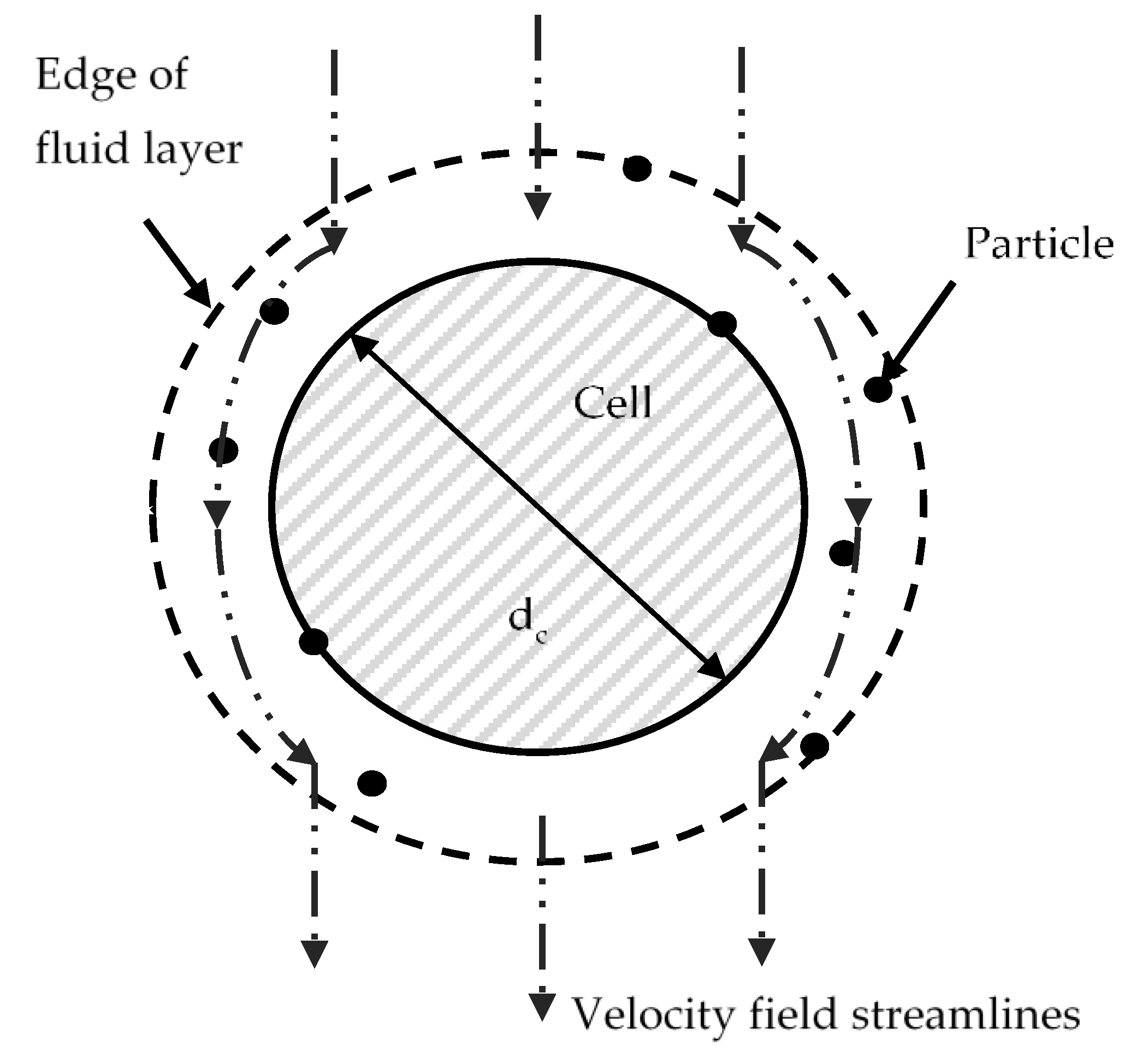

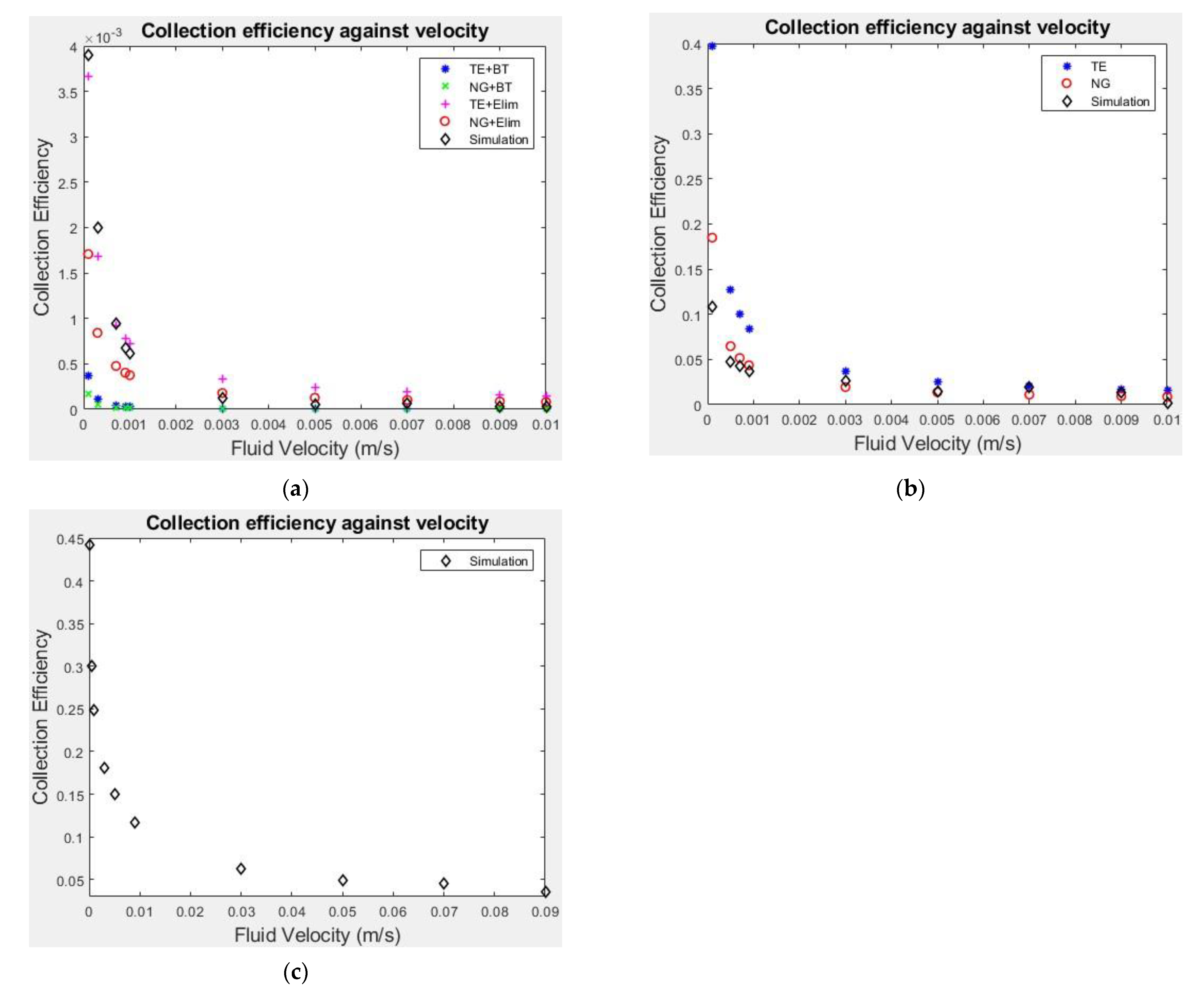
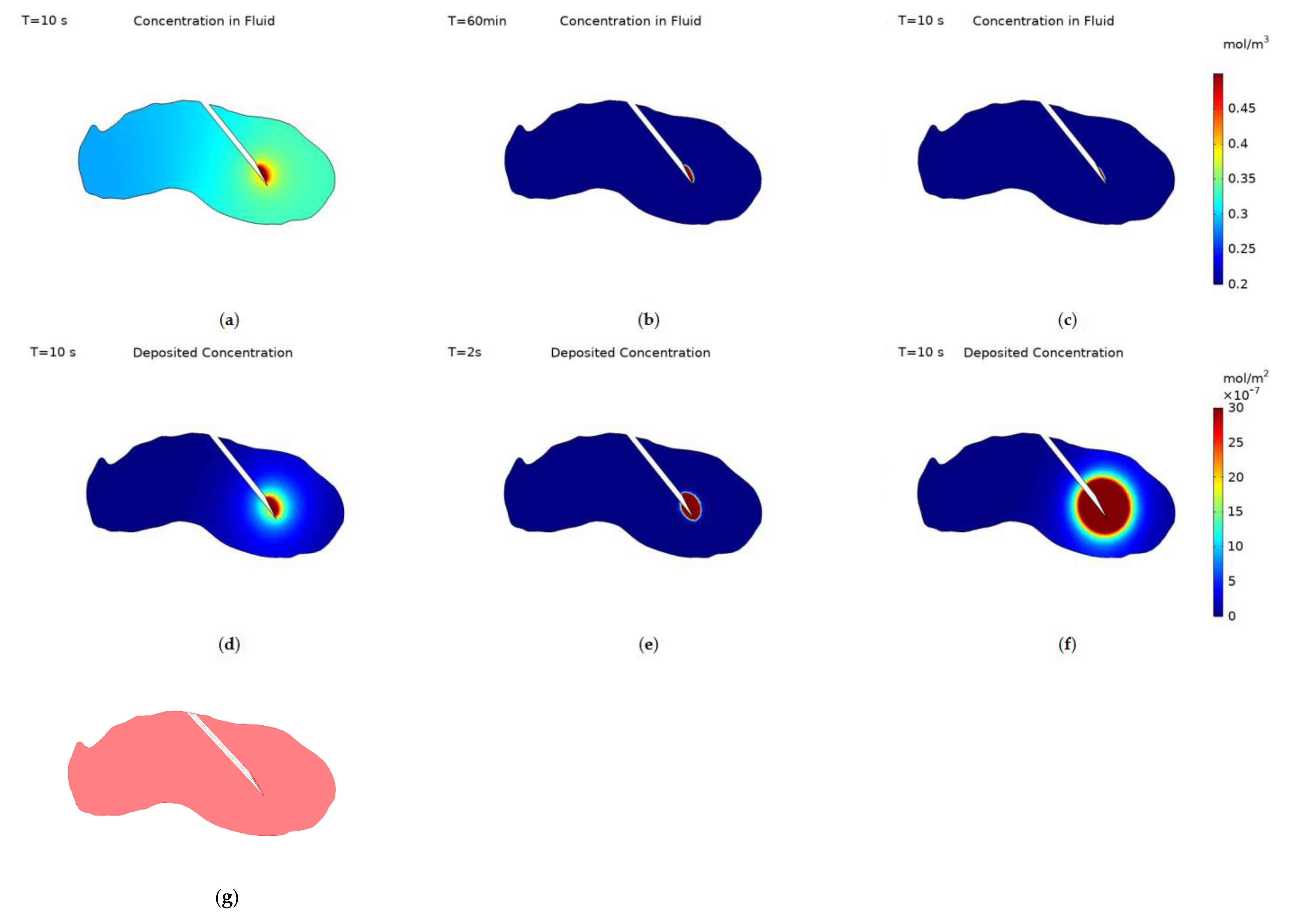
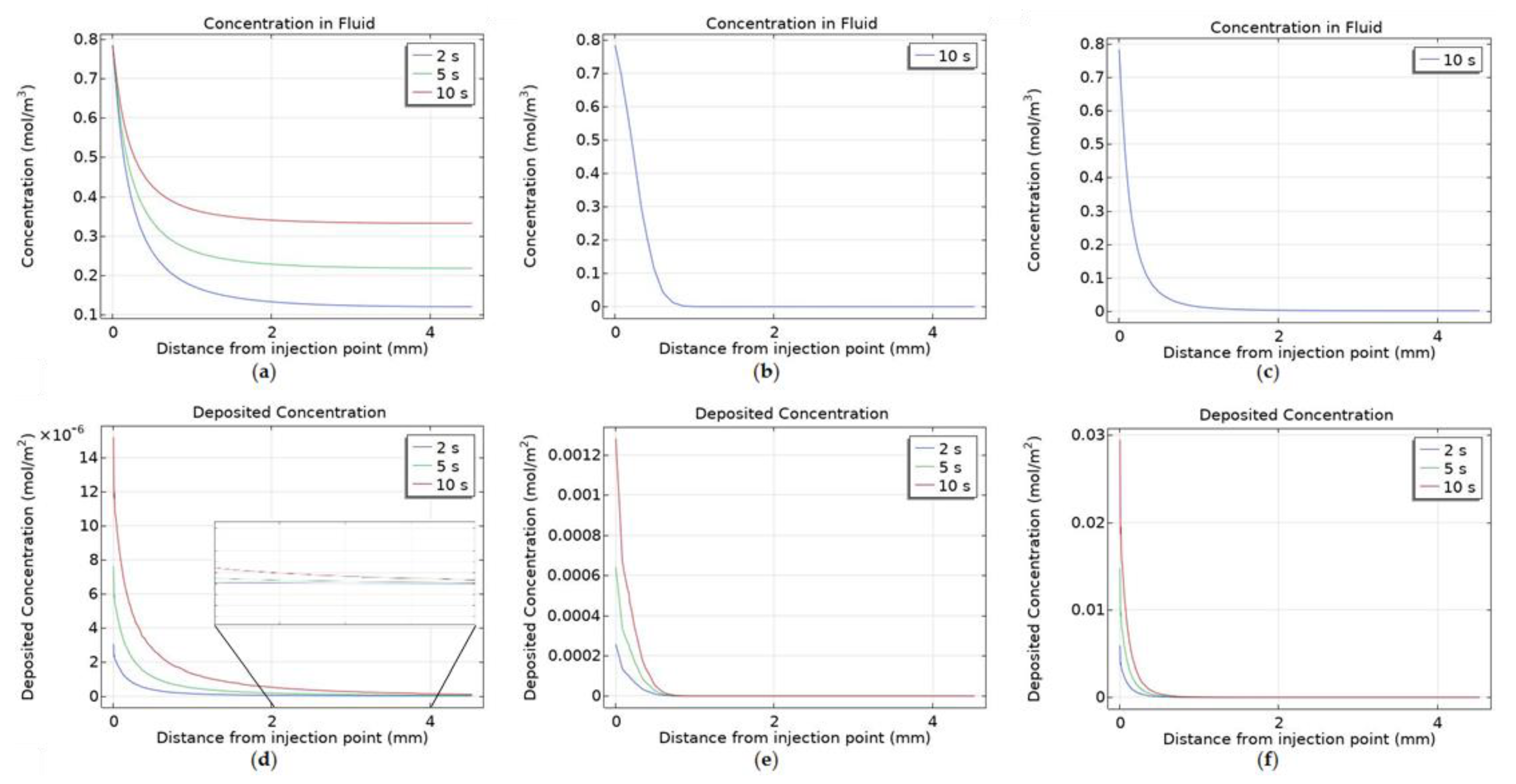


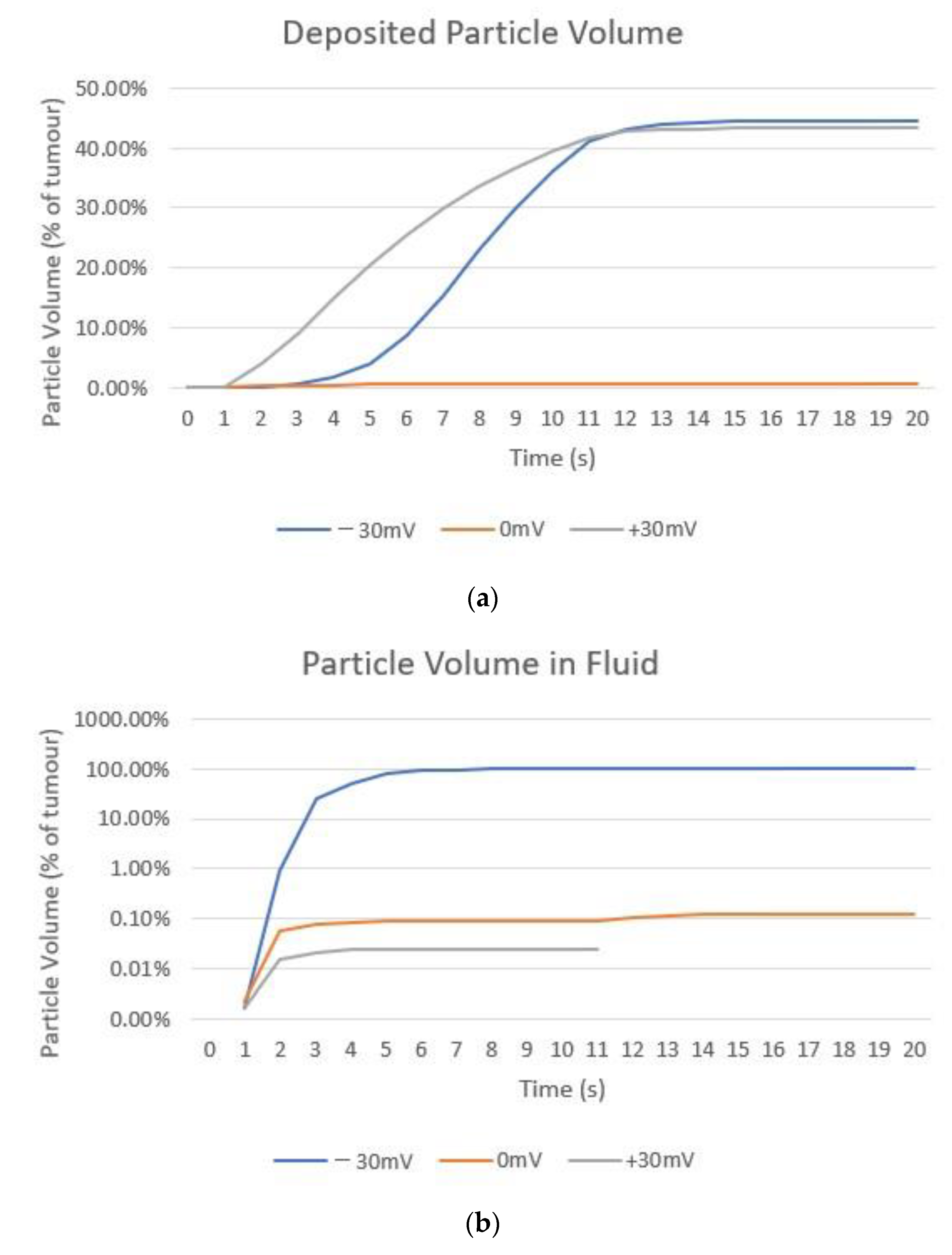

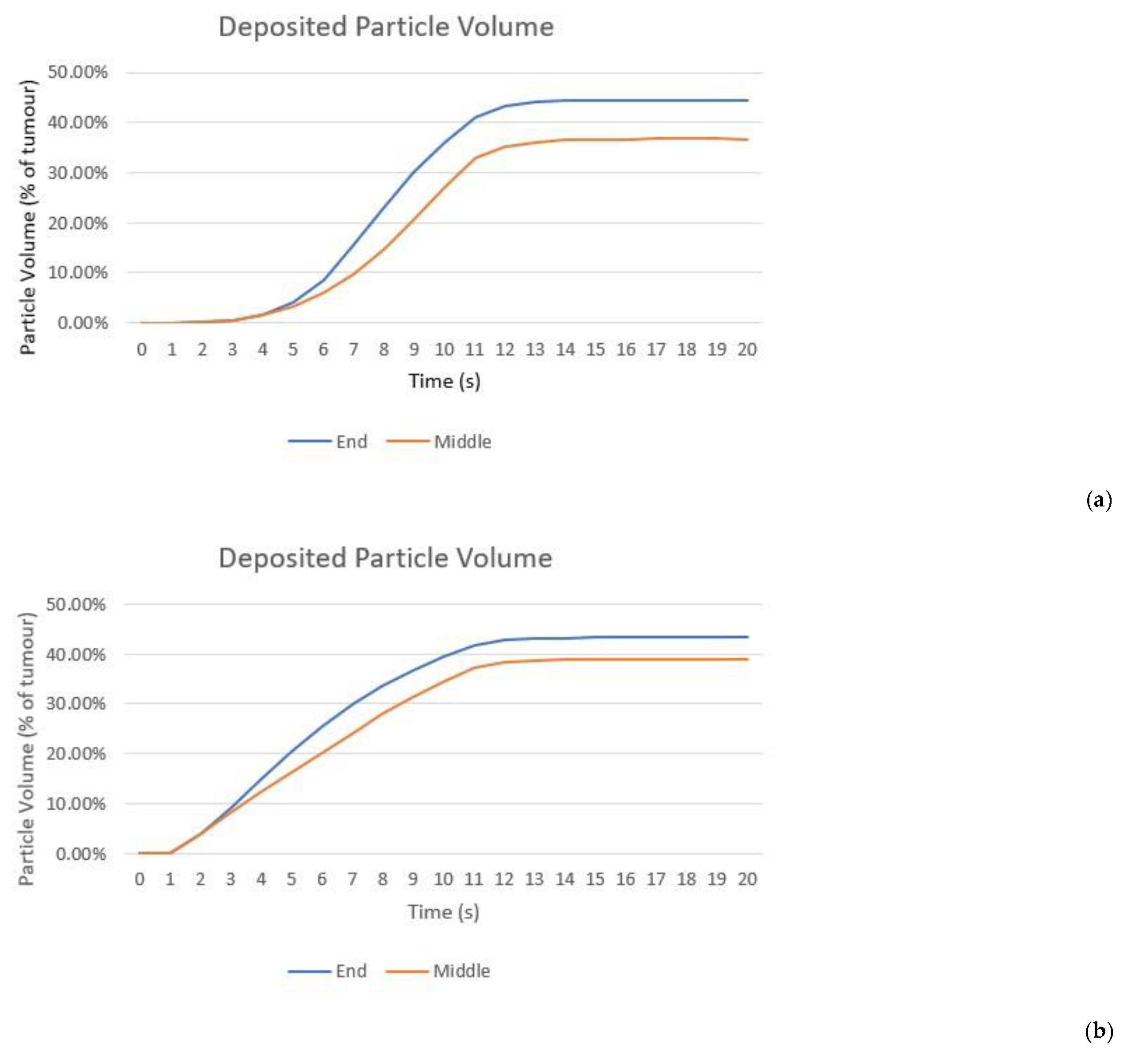
| Parameters and Properties | Values and Source |
|---|---|
| Injection Amount | 0.2 cc (*) |
| Injection Rate | 20 × 10−4 L/s (*) |
| Needle | 26 gauge (*) |
| Nanoparticle Concentration | 0.783 mol/m3 (*) |
| Tumour Porosity | 0.4 [18] |
| Tumour Permeability | 5 × 10−13 m2 [18] |
| Fluid Density | 960 kg/m3 [18] |
| Fluid viscosity | 3.5 × 10−3 kg/(ms) [37] |
| Nanoparticle diffusivity | 7.57 × 10−12 m2/s (0 mV) 1 × 10−5 m2/s (+/−30 mV) [37] |
| Time step | 0.1 s |
| Parameters and Properties | Values and Sources |
|---|---|
| Nanoparticle Density | 4230 kg/m3 |
| Cell Diameter | 15 × 10−6 m [18] |
| Cell Surface Charge | −20 mV [18] |
| Nanoparticle Diameter | 60 × 10−9 m (*) |
| Nanoparticle Surface Charge | −30 mV, 0 mV, 30 mV (*) |
| Fluid Velocity | 1 × 10−4–1 × 10−2 m/s |
| Time step | 1 × 10−5–5 × 10−8 s |
| Number of particles | 10,000–1,000,000 |
Publisher’s Note: MDPI stays neutral with regard to jurisdictional claims in published maps and institutional affiliations. |
© 2022 by the authors. Licensee MDPI, Basel, Switzerland. This article is an open access article distributed under the terms and conditions of the Creative Commons Attribution (CC BY) license (https://creativecommons.org/licenses/by/4.0/).
Share and Cite
Caddy, G.; Stebbing, J.; Wakefield, G.; Adair, M.; Xu, X.Y. Multiscale Modelling of Nanoparticle Distribution in a Realistic Tumour Geometry Following Local Injection. Cancers 2022, 14, 5729. https://doi.org/10.3390/cancers14235729
Caddy G, Stebbing J, Wakefield G, Adair M, Xu XY. Multiscale Modelling of Nanoparticle Distribution in a Realistic Tumour Geometry Following Local Injection. Cancers. 2022; 14(23):5729. https://doi.org/10.3390/cancers14235729
Chicago/Turabian StyleCaddy, George, Justin Stebbing, Gareth Wakefield, Megan Adair, and Xiao Yun Xu. 2022. "Multiscale Modelling of Nanoparticle Distribution in a Realistic Tumour Geometry Following Local Injection" Cancers 14, no. 23: 5729. https://doi.org/10.3390/cancers14235729
APA StyleCaddy, G., Stebbing, J., Wakefield, G., Adair, M., & Xu, X. Y. (2022). Multiscale Modelling of Nanoparticle Distribution in a Realistic Tumour Geometry Following Local Injection. Cancers, 14(23), 5729. https://doi.org/10.3390/cancers14235729





